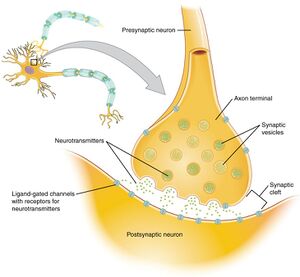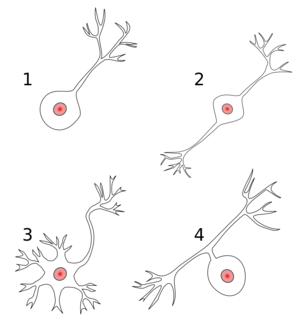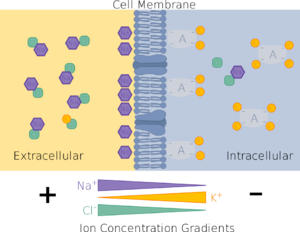Basic Neurophysiology
Neurons are cells derived from the same embryonic tissue as skin, namely the ectoderm. They are highly differentiated epithelial cells. Their membranes have a unique abilty to transmit electrical signals. The function of the neuron is to provide a rapid transmission of information, which is often over large distances.
Terminology
Basic Structure
Motor Neuron and CNS Neurones
The nucleus is located in the cell body. Dendrites detect information to deliver to the cell. detect From the cell body is an extension of the membrane known as the axon that delivers information to a remote site. The axon terminal is called the telodendron.
Pseudounipolar Neurons - Sensory
In the peripheral nervous system, neurons have an analogous structure. In this situation, the cell body is offset from the axon. These cells are designed to reach out into the periphery to receive information. Their distal terminals have a receptor that detect stimuli from peripheral tissues, and is analogous to the dentrite. The axon refers to the entire conducting component of the cell, i.e. everything except the cell body.
Membrane Potential
A nerve cell is able to maintain a membrane potential, abbreviated as Vm. Inside the cell are proteins that have a negative charge, and attract ions such as sodium and potassium. In the cell membrane are sodium and potassium pumps. They expel sodium ions and take up potassium ions. A concentration gradient is formed, with the net effect being that there is a relative positive charge outside the membrane and a negative charge inside the membrane. There is therefore a potential gradient across the membrane, and this measures around -90mV.
There are also channels in the cell membrane that can transmit sodium or potassium. At rest the channels are closed. The gates are able to open allowing sodium to rush into the cell, and potassium to rush outside the cell.
Nerve Functions
Transduction
This is the ability to detect the stimulus. At the terminal of the nerve fibre is the receptor membrane, which can respond to a variety of stimuli. These stimuli can include mechanical, thermal, or chemical influences. The stimulus causes a deformation of the membrane, with the result being that sodium leaks into the nerve terminal. This creates a generator potential. As more sodium moves into the cell, the membrane potential change increases, leading to a greater depolarisation of the membrane. As the amplitude increases, it has a spread of influence along the length of the receptor membrane, this is called electro-tonic spread. The electro-tonic spread eventually reaches the conducting membrane of the neuron.
Conduction
Transmission

Transmission begins when the action potential reaches the central terminal. There are vesicles in the central end of the axon which contain transmitter substances. When the action potential arrives at the terminal, the vesicles are pushed into surface of the membrane, and they release the transmitter substances outside the cell.
The common transmitter substances are
- Acetylecholine
- Noradrenaline
- Serotonin (5-hydroxytrptamine)
- Glycine
- Substance P
- Glutamate
- Enkephalin
These transmitter substances may be uniquely released, or there may be several substances released simultaneously. These substances act on the receiving neuron. The dentrites of the receiving neuron contain dentrites that have receptors for these substances. With chemical bonding a miniature potential is generated. The potential is increased with more bonding of transmitter substances to receptors, eventually causing a depolarisation of the dentrite. This depolarisation spreads across the cell body generating an action potential.
The terminal aspect of the primary neuron is called the pre-synaptic membrane. The receiving membrane is called the post-synaptic membrane. The junction is called the synapse. The communication between these two nerves is chemical not electrical.
A synapse provides the ability to control the flow of information. If control isn't required then neither is a synapse. Many nerves can transmit to one receiving nerve. Some of these may be excitatory and other inhibitory.
Another important function is the termination of action of transmitters. One method of termination is the natural tendency for transmitter substances to diffuse away. Another mechanism is the transmitting neuron can re-uptake the transmitter substances. This allows recycling back into vesicles. A third mechanism is deactivation by enzymes. Enzymes can be found in synapses which changes the nature of the molecule so that it no longer has an effect on the receiving neuron.
The types of transmitter substances are defined by their substances. Only certain substances can act on certain receptors.
Inhibition of membranes can occur as well as depolarisation through inhibitory transmitter substances. These inhibit the responsiveness through a process called hyperpolarisation by allowing potassium to leak out of the receiving neuron. The resting potential of the potential, which is normally around -70mV, is increased. This means a stronger stimulus is required to allow depolarisation to the threshold of -55mV.



